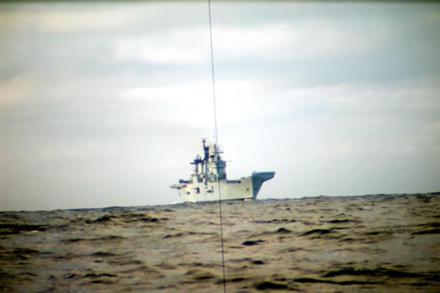And reactors do make noise because they need constant cooling flow once they're critical
This is true, but a very oversimplified answer. The USN reactors in various SSN's do need constant cooling, but what you aren't saying is that at low power output levels, the pumps which MAKE the noise from the "constant cooling flow" you're talking about aren't needed to be run. The design of the cooling fluid loop and other classified stuff is such that, as I said, there is no additional noise generated as there is nothing running that would do so. Once power is increased to add revolutions to the screw, which is how you get more power/speed, only then are pumps needed to increase the flow/cooling rate. This is called "natural circulation technology". This and many other things engineered into the design of the reactors on the 688, Seawolf, Virginia, Ohio's, and all their predecessors are specifically made to make things quieter by eliminating additional sound sources like reactor cooling pumps at slower speeds. When the coolant is circulating on its own, the only noise would be the movement of fluid through the piping and vessel itself, which makes little if any detectable signatures outside of the hull.
So, while reactors do need constant cooling, it isn't just from cooling pumps that this is accomplished depending on power/speed of the submarine.
Also, regarding AIP powered submarines, the idea that they can only creep at "a few knots" in order to stay submerged is ridiculous. The German, Swedish, and other boats currently in service can run at 25 knts or higher at max power, and do long range cruises at 15 knts and still have weeks of patrolling left in them with regards to fuel/fuel cell/etc for the AIP propulsion systems. The reason D/E subs could and would only run at very slow creep speeds was that their batteries charge would be very quickly depleted during high power/speed runs and settings, requiring them to snorkel and run the diesel motors to recharge, which creates a huge sound signature- well the AIP are NOT batteries which need to be recharged due to quickly discharging their power levels during high speed maneuvers. That's the revolutionary part of AIP, it isn't just that snorkeling is virtually eliminated, although the AIP subs still do it to recharge their batteries, it's that the need to snorkel is reduced by an order of magnitude, as the AIP system can power the boat completely independently of the old diesel/electric circuit. D/E subs until the advent of AIP systems were pretty much a manned, moveable minefield. That just isn't the case any more, and while they don't have the speed or range of the fleet SSN's, they aren't tied to a coastline or supply vessel nearly as much as they formerly were. The Israeli Dolphins, German 212/etc, Swedish and Aussie boats, and others, have all come across both the Pacific and Atlantic oceans to the USA home waters to train, and most of them effected their crossings at 10-15 knts sustained.
Newer US subs like the Seawolf and Virginia have new classified sonar systems specifically designed to detect AIP subs, and the specific frequency and such that these propulsion systems operate around. That's how effective the AIP systems have been, they spawned a completely new type of detection system. How good it works in doing so isn't being told to the public much.
One thing I've read about in a lot of the defense sites and journals is that the US Navy since the decline of the USSR's sub fleet has spent less time and money on the training of the surface combatant fleets in ASW work. That is completely understandable, when a threat diminishes, and other threats pop up, you change to meet that threat, right? IMO this is an important factor in the success of small AIP and D/E subs in exercises vs US Navy frigs and destroyers. The Aussies, Swedes, Germans, and even Canadian navies with their small subs have had a lot of publicized success recently, but I'm not convinced that it is merely a technological leap, and I feel that it is also a training and focus issue as well.
I will agree that while the AIP subs are ground breaking, they are certainly NOT as capable as a fleet SSN in terms of the ranges they can be deployed at, and their sustainability. All subs are governed by the food and supplies they can store, it used to be that the D/E subs were limited by fuel and range/speed due to the nature of their systems, but the AIP systems have pushed that to at least 60 days of combat ops in terms of power levels/speed settings, so they are catching up to the SSN's, but they'll never catch or overtake them IMO. Current US SSN's are at least 10 knts faster at max power settings, and that's likely on the low side, and can keep that up indefinitely, where as an AIP/DE sub can only get short bursts by comparison.
D/E non AIP subs are still dangerous as well. Even though they don't have the range/speed options that the AIP subs do, they can still be effective. The HMS Illustrious is the "varsity" in the Nato/USN fleets for ASW work - this ship and crew has "the" reputation for hunting subs in exercises. Well, a newcomer to the block, an x-brit D/E sub from the Canadian Navy did this to them in a EX just a couple of years ago. This proves the point IMO that even really good, well trained and experienced surface crews are usually at a disadvantage to even a D/E sub in a fight.

At this range it's only a 2 minute run for a Mk48 ADCAP torpedo - just not enough time to evade it from a head on quartering shot like this, and in a real war, that ASW ship would have taken hits for a virtual certainty.